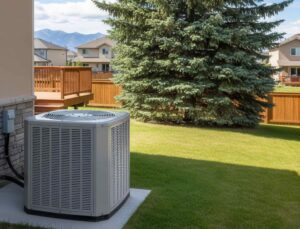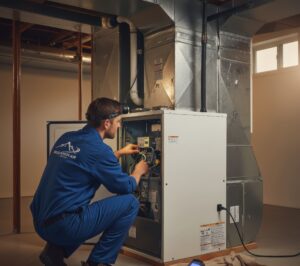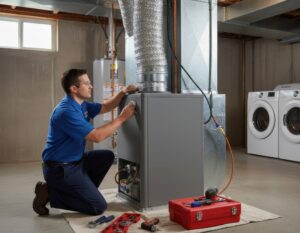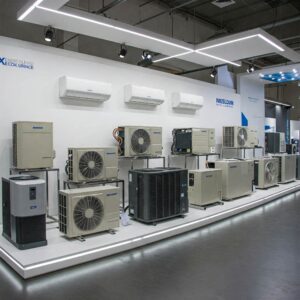Poor indoor air quality is a growing problem in Alberta. It leads to a home’s residents feeling sick, tired, and having breathing problems. Homes in the northern latitudes, like Alberta, are heavily insulated to protect them from the winter’s cold. This can cause irritants, pollutants, and other contaminants to get trapped in the house and be recycled through the home’s ventilation system for years. For this reason, Alberta residents need to have their indoor air quality tested periodically.
WHAT ARE WELL-KNOWN HAZARDS AFFECTING ALBERTA HOMES’ INDOOR AIR QUALITY?
Some of Alberta homes’ most well-known air hazards are radon, mold, and mildew. However, other things impact air quality, including how air circulates in the house, the materials used to build the home, and how clean or dirty the indoor space is.
Many are surprised to learn that the components that produce the smell of a fresh coat of paint or that new plastic smell when you hang up a new shower curtain are negatively impacting indoor air quality. There are many pollutants in the air that homeowners are not aware of.
What makes addressing indoor air quality a challenge is that most pollutants are unseen by the human eye. When most people think about air pollutants, they think about the smog billowing out of large buildings or the visible exhaust from a poorly tuned vehicle. However, the air pollutants that affect people the most are invisible, like microscopic particles, benzene, formaldehyde, and viruses.
Air pollutants can emanate from seemingly mundane things in your home, like paint, furniture, and the products used to clean your home, and some of them, like radon, can seep up from beneath the ground. Fungi, bacteria, and biological pollutants develop in your home if there are water leaks or unmitigated moisture. Dust, asbestos, and combustion are other common hazards affecting homes in Alberta. In addition to the everyday, obvious hazards, factors that impact air quality that people don’t think about are humidity and the air temperature and how these could jeopardize the air’s ability to circulate.
WHEN SHOULD I HAVE MY INDOOR AIR QUALITY TESTED?
At Alberta Mountain Air Heating and Air Conditioning, we encourage our clients to use their five senses and observations when determining when an air quality test should be done. There are several physical indications of poor air quality. For example, you might see water damage on your walls, ceilings, or floors. Or you may smell mold or mildew. Other odors, like those associated with chemical emissions, gas leaks, or new building materials, are critical signs that something is off with the air in your home.
You might know that your building is old enough to have lead paint and asbestos, or you may have been informed that your area has a high radon level. All of these things are signs that you need to have your air quality tested.
Air quality monitors can help you identify changes to indoor air quality that could indicate you need a professional assessment. Odors are an excellent way to tell that you need to have an indoor air quality test, but unfortunately, some of the most dangerous pollutants do not have an odor. Air quality monitors give a level of visibility to invisible pollutants. The truth is everyone in Alberta will have some indoor air quality issue at some point that will need to be addressed.
Although there are some do-it-yourself air quality testing kits, at Alberta Mountain Air Heating and Air Conditioning, we believe it is best to leave this sensitive task to professionals. This is because air quality is a complex world. Accurately gauging indoor air quality means completely understanding guidelines laid out by regulatory bodies like the EPA, the American Industrial Hygiene Association, and OSHA. When you work with a professional, you know that they are taking indoor air quality samples using state-of-the-art professional-grade equipment. They are trained to investigate indoor air quality concerns and not just gather samples using testing equipment. It is a thorough assessment carried out by competent professionals.
An example of the benefit of using professionals for indoor air quality testing is that if a homeowner stores bleach and ammonia next to each other, it could create a terrible smell that is difficult to identify. A professional will immediately identify this dangerous mistake. Because of their training, they see the whole picture and can extrapolate based on the experience they have garnered over the years and then use that experience to correct air quality issues.
HEALTH TRIGGERS THAT INDICATE IT’S TIME TO GET YOUR INDOOR AIR QUALITY TESTED
A person can feel poor air quality. It is seen with symptoms like congestion, cough, or headache, especially if these symptoms are only felt when inside your home. Health issues associated with low indoor air quality may be experienced quickly after exposure or may only arise years later.
Indoor air quality concerns could mimic other diseases. Some people who live in homes with poor indoor air quality are constantly getting sick and having stuffy noses, headaches, headaches, and problems concentrating. In addition to health triggers, you may notice that your home gets dusty quickly or that energy bills are higher than usual because of completely or partly blocked airways. If you experience any of the above-mentioned symptoms, it may be a good time to talk to the professionals at Alberta Mountain Air Heating and Air Conditioning about testing your indoor air quality.
GET YOUR AIR TESTED WHEN MOVING TO A NEW LOCATION
It is recommendable that you have a complete panel of tests done when moving into a new location. HVAC professionals can test your air quality for lead, VOCs, dust mites, pollen, and other contaminants. Identifying dangerous contaminants as soon as possible is a good idea.
Certain pollutants like radon, lead, or pollen could be present as soon as you move in. Dust mites and VOCs might be present after you move in because the level of these pollutants will vary based on the furniture you have, your habits, and the cleaning supplies you use. In this case, you may want to wait a couple of months after moving in so you can get a clear picture of what the air quality of your home is truly like with your entire family living there.
Mold and pollen levels can vary based on the season. They might not be present during the winter, but they will be present during the spring and summer. For this reason, some homeowners contact us at Alberta Mountain Air Heating and Air Conditioning to have the air quality tested the first spring and fall after they moved in.
EXCEPTIONAL HEATING AND AIR CONDITIONING IN CALGARY
At Alberta Mountain Air Heating and Air Conditioning, we have been providing unparalleled HVAC and air quality control services in Calgary for close to two decades. We are Lennox premier dealers, and our team is SAIT certified. We are proud of our A+ Better Business Bureau accreditation and have received The Workplace Safety Certificate of Recognition.
Our services include HVAC installation, repair, and maintenance. We install ductless mini-splits and perform indoor air quality testing and improvements. Contact Alberta Mountain Air Heating and Air Conditioning today to learn why we are one of the best at what we do in the Calgary area.





